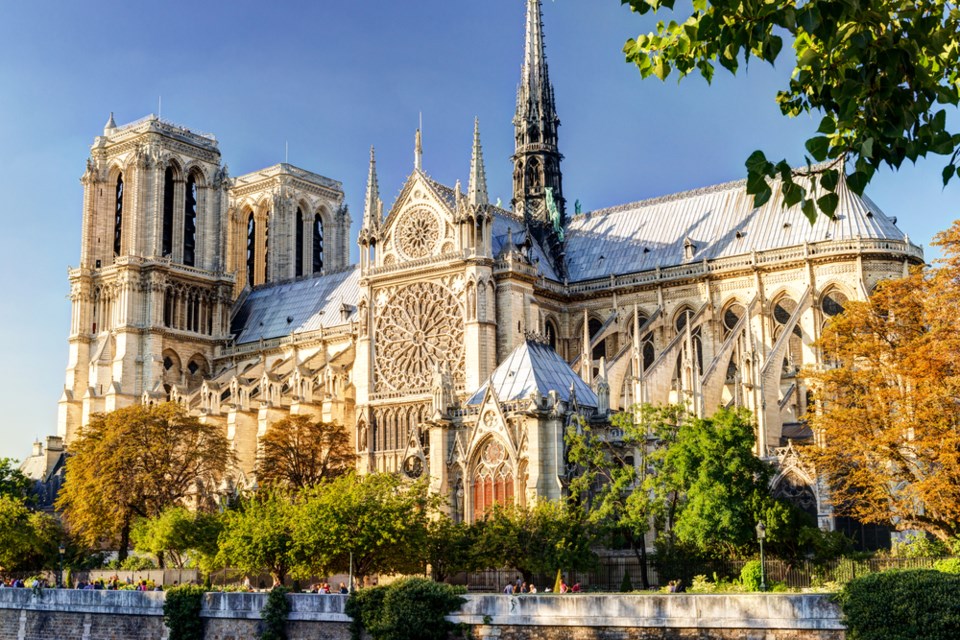Earlier this week a catastrophic fire damaged the Notre Dame Cathedral in Paris. The structure is officially known as Notre-Dame de Paris, which means, “Our Lady of Paris.” It is considered a masterpiece of gothic architecture. This week we are focusing on five facts about Notre Dame.
By the numbers
Notre Dame stands on the Île de la Cité, a small island in the Seine River. The building is situated near Point Zero, which serves as a reference to where distances all other places are measured. Point Zero is said to be the exact centre of Paris.
Construction began in 1163 but was not finished until 1345. The towers were finished around 1245. The central spire was added in the 1850s. The interior of the cathedral is 427 feet by 157 feet. The towers are 223 feet high.
The massive organ has over 7,000 pipes. Some of the pipes are from the 18th century. The organ was refurbished in 2013.
Approximately 13 million people visit Notre Dame each year and the average wait time to visit is 120 minutes. It is the most visited monument in Paris.
Repairing Notre Dame is expected to cost $8 billion. Almost $1 billion has already been donated.
Priceless Treasures
There are several priceless relics kept at Notre Dame. Some were kept inside the copper rooster, which sat atop the spire, which was destroyed by the fire. The rooster has been recovered, although it has been damaged.
Of course, Notre Dame also has sacred items like the Crown of Thorns, which was reputedly worn by Jesus during the crucifixion. The collection also includes a piece of the True Cross and one of the Holy Nails. It is said that none of these items were lost in the fire.
Other valuable items like artwork and sculptures were also housed at Notre Dame. It is unclear what exactly was saved.
Quasimodo’s Influence
It seems hard to believe now, but at one point Notre Dame was in bad shape. The cathedral had been neglected and was in a state of disrepair. Writer Victor Hugo did not like seeing Notre Dame in this condition. He therefore used the location for the setting of his next novel, The Hunchback of Notre Dame, to ensure that others would see the value in gothic architecture. It worked; the novel enthralled readers and stirred interest in the building. This led to the government forming the Commission on Historical Monuments, which then set about restoring Notre Dame.
Meet the Bells
There are 10 bells at Notre Dame. The original bells were taken from the cathedral and melted into canon balls during the French Revolution. The newest bells were replaced in 2013. The bells have individual names, with each bearing the name of a saint. Their names are Marie, Gabriel, Anne Genevieve, Denis, Marcel, Etienne, Benoit-Joseph, Maurice, Jean-Marie, and Emmanuel. Each is tuned to a different note. Emmanuel is the largest bell weighing in at 13 tons. It dates back to 1681.
Gargoyles, Chimeras, and Grotesques — Oh My!
While we tend to think of any monstrous figure on the side of a building as a gargoyle, that is inaccurate. True gargoyles have a function — they serve as drain spouts. This of course applies to the famous gargoyles of Notre Dame. In fact, it is worth noting that the name gargoyle is French in origin; it comes from the French word “gargouille,” which means throat or gullet. Chimeras, on the other hand, are what people more commonly refer to as “gargoyles.” They are purely ornamental in nature. “Grotesque” is a generic term referring to any stone carving, whether it is functional or decorative.
Although gargoyles have been used for many years, eventually they fell out of favour and have been replaced by downspouts. This is because gargoyles are heavy and there is a risk they can fall off the building. In fact, the 1724 London Building Act actually required all new buildings to use downspouts.




